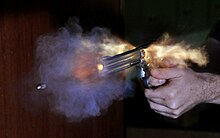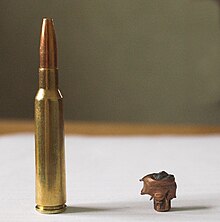Solid or monolithic solid: mono-metal bullets intended for deep penetration
in big game animals and slender shaped very-low-drag projectiles for long
range shooting are produced out of metals like oxygen-free copper and alloys
like cupronickel, tellurium copper and brass (e.g., highly machinable UNS
C36000 free-cutting brass). Often these projectiles are turned on precision
CNC lathes. In the case of solids, and the ruggedness of the game animals on
which they are used, e.g., the African buffalo or elephant, expansion is
almost entirely relinquished for the necessary penetration. In shotgunning,
"slug" loads are often solid large single lead projectiles, sometimes with a
hollow point, used for deer or wild pig hunting in jurisdictions that do not
allow hunting with rifles (because a missed slug shot will travel
considerably less far than a rifle bullet).
|
|
|
- Fluted: in appearance, these are solid bullets with scalloped sides
(missing material). The theory is that the flutes produce hydraulic jetting
when passing through tissue, creating a wound channel larger than that made
by conventional expanding ammunition such as hollow point bullets.
- Hard cast: a hard lead alloy intended to reduce fouling of rifling grooves
(especially of the polygonal rifling used in some popular pistols). Benefits
include simpler manufacture than jacketed bullets and good performance
against hard targets; limitations are an inability to mushroom and
subsequent over-penetration of soft targets.
Blank: wax, paper, plastic, and other materials are used to simulate live
gunfire and are intended only to hold the powder in a blank cartridge and to
produce noise, flame and smoke. The "bullet" may be captured in a
purpose-designed device or it may be allowed to expend what little energy it
has in the air. Some blank cartridges are crimped or closed at the end and do
not contain any bullet; some are fully loaded cartridges (without bullets)
designed to propel rifle grenades. The force of the expanding gas from blank
cartridges can be lethal at short range; numerous tragic accidents have occurred
with blank cartridges (e.g., the death of actor Jon-Erik Hexum). Practice: made
from lightweight materials like rubber, wax, wood, plastic, or lightweight
metal, practice bullets are intended for short-range target work only. Because
of their weight and low velocity, they have limited range.
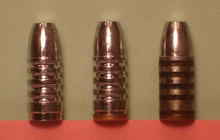
A modern centerfire cartridge consisting of the following: 1. bullet, as the
projectile; 2. metallic case, which holds all parts together; 3. propellant,
for example gunpowder or cordite;4. rim, which provides the extractor on the
firearm a place to grip the case to remove it from the chamber once fired;
5. primer, which ignites the propellant.
| |
Polymer: these are metal-polymer composites, generally lighter and having
higher velocities than pure metal bullets of the same dimensions. They
permit unusual designs that are difficult with conventional casting or
lathing.
Less lethal, or less than lethal: Rubber bullets, plastic bullets, and
beanbags are designed to be non-lethal, e.g., for use in riot control. They
are generally low velocity and are fired from shotguns, grenade launchers,
paint ball guns, or specially designed firearms and air gun devices.
Incendiary: these bullets are made with explosive or flammable mixtures in
the tips that are designed to ignite on contact with a target. The intent is
to ignite fuel or munitions in the target area, thereby adding to the
destructive power of the bullet.
Exploding: similar to the incendiary bullet, this type of projectile is
designed to explode upon hitting a hard surface, preferably the bone of the
intended target. Not to be mistaken for cannon shells or grenades with fuse
devices, these bullets have only cavities filled with a small amount of high
explosive depending on the velocity and deformation upon impact to detonate.
Exploding bullets have been used in various heavy machine guns and in anti
-materiel rifles.
Tracer: these have hollow backs, filled with a flare material. Usually this
is a mixture of magnesium, a perchlorate, and strontium salts to yield a bright
red color, although other materials providing other colors have also sometimes
been used. Tracer material burns out after a certain amount of time. This allows
the shooter to visually trace the flight path of the projectile and thus make
necessary ballistic corrections, without having to confirm projectile impacts
and without even using the sights of the weapon. This type of round is also
used by all branches of the United States military in combat environments as a
signaling device to friendly forces. Normally it is loaded at a four to one
ratio with ball ammunition.
Armor-piercing: jacketed designs where the core material is a very hard,
high-density metal such as tungsten, tungsten carbide, depleted uranium, or
steel. A pointed tip is often used, but a flat tip on the penetrator portion
is generally more effective.[34]
Nontoxic shot: steel, bismuth, tungsten, and other alloys prevent release
of toxic lead into the environment. Regulations in several countries mandate
the use of nontoxic projectiles especially when waterfowl hunting. It has
been found that birds swallow small lead shot for their gizzards to grind
food (as they would swallow pebbles of similar size), and the effects of
lead poisoning by grinding of lead pellets against food means lead poisoning
effects are magnified. Such concerns apply primarily to shotguns firing
pellets (shot) and not bullets, but there is evidence suggesting that
consumption of spent rifle and pistol ammunition is also hazardous to
wildlife.[35] Reduction of hazardous substances legislation has also been
applied to bullets on occasion to reduce the impact of lead on the
environment at shooting ranges.
Blended-metal: bullets made using cores from powdered metals other than
lead with binder or sometimes sintered.
Frangible: designed to disintegrate into tiny particles upon impact to
minimize their penetration for reasons of range safety, to limit
environmental impact, or to limit the shoot-through danger behind the
intended target. An example is the Glaser Safety Slug, usually a pistol
caliber bullet made from an amalgam of lead shot and a hard (and thus
frangible) plastic binder designed to penetrate a human target and release
its component shot pellets without exiting the target.
Multiple projectile: bullets that are made of separate slugs that fit
together inside the cartridge and act as a single projectile inside the
barrel as they are fired. The projectiles part in flight but are held in
formation by tethers that keep the individual parts of the "bullet" from flying
too far away from each other. The intention of such ammo is to increase hit
chance by giving a shot-like spread to rifled slug firing guns, while
maintaining a consistency in shot groupings. Multiple impact bullets may be
less stable in flight than conventional solid bullets because of the added
drag from the tether line holding the pieces in formation, and each
projectile affects the flight of all the others. This may limit the benefit
provided by the spread of each bullet at longer ranges.
Treaties and prohibitions
Poisonous bullets were a subject to an international agreement as early as the
Strasbourg Agreement (1675). The Saint Petersburg Declaration of 1868 prohibited
the use of explosive projectiles weighing less than 400 grams.[36] The Hague
Conventions prohibits certain kinds of ammunition for use in war. These include
poisoned[37][38] and expanding[39][40] bullets. Protocol III of the 1983
Convention on Certain Conventional Weapons, an annexed protocol to the Geneva
Conventions, prohibits the use of incendiary ammunitions against civilians.[41]
Types of bullets
Some types of bullets include:
- Armor piercing (sometimes with a depleted uranium or other heavy metal core)
- Armor-piercing fin stabilized discarding sabot round
- Cast
- Expanding (hollow point, soft point)
- Frangible
- Full metal jacket (also known as "ball" ammunition)
- Hollow-base
- Hollow-point
- Hydra-Shok
|
- Nosler partition
- Plastic-tipped
- Sabot
- Saboted light armor penetrator
- Spitzer
- Semiwadcutter
- Total metal jacket
- Very low drag
- Wadcutter
- Wax
|
See also
- Flechette
- List of handgun cartridges
- List of rifle cartridges
- Meplat
- Smart bullet
- Table of handgun and rifle cartridges
- The Second Amendment to the US Constitution
|
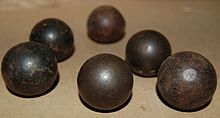
 Delvigne further developed cylindro-spherical (left) and cylindro-conical
bullets (middle), which received the bullet grooves developed by Tamisier
for stability
Delvigne further developed cylindro-spherical (left) and cylindro-conical
bullets (middle), which received the bullet grooves developed by Tamisier
for stability
 Before Tamisier's invention, the orientation of a cylindro-conical bullet tended
to remain along its inertial axis, progressively setting it against its
trajectory and increasingly meeting air resistance, which rendered the bullet's
movement erratic.
Before Tamisier's invention, the orientation of a cylindro-conical bullet tended
to remain along its inertial axis, progressively setting it against its
trajectory and increasingly meeting air resistance, which rendered the bullet's
movement erratic.
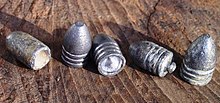
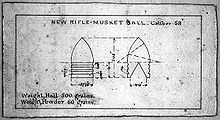
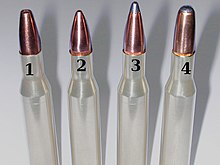 .270 Winchester ammunition:
.270 Winchester ammunition:

